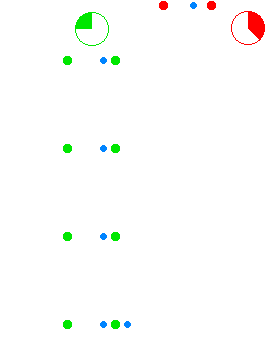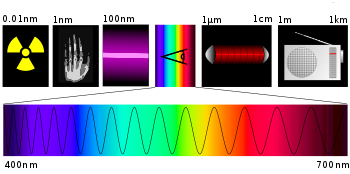Electromagnetic wave equation
The electromagnetic wave equation is a second-order partial differential equation that describes the propagation of electromagnetic waves through a medium or in a vacuum. The homogeneous form of the equation, written in terms of either the electric field E or the magnetic field B, takes the form:
where c is the speed of light in the medium. In a vacuum, c = 2.998 x 108 meters per second, which is the speed of light in free space.
The electromagnetic wave equation derives from Maxwell's equations.
It should also be noted that in most older literature, B is called the "magnetic flux density" or "magnetic induction".
Speed of propagation
In vacuum
If the wave propagation is in vacuum, then
- meters per second
is the speed of light in vacuum. The magnetic constant and the vacuum permittivity are important physical constants that play a key role in electromagnetic theory.
| Symbol | Name | Numerical Value | SI Unit of Measure | Type |
|---|---|---|---|---|
| Speed of light in vacuum | meters per second | defined | ||
| vacuum permittivity | Farads per meter | derived | ||
| magnetic constant | Henries per meter | defined |
In a material medium
The speed of light in a linear, isotropic, and non-dispersive material medium is
where
is the refractive index of the medium, is the magnetic permeability of the medium, and is the electric permittivity of the medium.
The origin of the electromagnetic wave equation
Conservation of charge
Conservation of charge requires that the time rate of change of the total charge enclosed within a volume V must equal the net current flowing into the surface S enclosing the volume:
where j is the current density (in Amperes per square meter) flowing through the surface and ρ is the charge density (in coulombs per cubic meter) at each point in the volume.
From the divergence theorem, this relationship can be converted from integral form to differential form:
Ampère's circuital law prior to Maxwell's correction
In its original form, Ampère's circuital law relates the magnetic field B to the current density j:
which can be converted to differential form, using Stokes' theorem:
Inconsistency between Ampère's circuital law and the law of conservation of charge
Taking the divergence of both sides of Ampère's circuital law gives:
The divergence of the curl of any vector field, including the magnetic field B, is always equal to zero:
Combining these two equations implies that
Because is nonzero constant, it follows that
However, the law of conservation of charge tells that
Hence, as in the case of Kirchhoff's circuit laws, Ampère's circuital law would appear only to hold in situations involving constant charge density. This would rule out the situation that occurs in the plates of a charging or a discharging capacitor.
Maxwell's correction to Ampère's circuital law
Gauss's law in integral form states:
which can be converted to differential form using the divergence theorem:
Taking the time derivative of both sides and reversing the order of differentiation on the left-hand side gives:
This last result, along with Ampère's circuital law and the conservation of charge equation, suggests that there are actually two origins of the magnetic field: the current density j, as Ampère had already established, and the so-called displacement current:
So the corrected form of Ampère's circuital law becomes:
Maxwell's hypothesis that light is an electromagnetic wave

In his 1864 paper entitled A Dynamical Theory of the Electromagnetic Field, Maxwell utilized the correction to Ampère's circuital law that he had made in part III of his 1861 paper On Physical Lines of Force. In PART VI of his 1864 paper which is entitled 'ELECTROMAGNETIC THEORY OF LIGHT'. [1] (page 497 of the article and page 9 of the pdf link) Maxwell combined displacement current with some of the other equations of electromagnetism and he obtained a wave equation with a speed equal to the speed of light. He commented:
- The agreement of the results seems to show that light and magnetism are affections of the same substance, and that light is an electromagnetic disturbance propagated through the field according to electromagnetic laws.
(see [2], page 499 of the article and page 1 of the pdf link)
Maxwell's derivation of the electromagnetic wave equation has been replaced in modern physics by a much less cumbersome method involving combining the corrected version of Ampère's circuital law with Faraday's law of induction.
To obtain the electromagnetic wave equation in a vacuum using the modern method, we begin with the modern 'Heaviside' form of Maxwell's equations. In a vacuum, these equations are:
Taking the curl of the curl equations gives:
By using the vector identity
where is any vector function of space, it turns into the wave equations:
where
- meters per second
is the speed of light in free space.
Covariant form of the homogeneous wave equation

These relativistic equations can be written in covariant form as
where the electromagnetic four-potential is
with the Lorenz gauge condition:
- .
Here
- is the d'Alembertian operator. The square box is not a typographical error; it is the correct symbol for this operator.
Homogeneous wave equation in curved spacetime
The electromagnetic wave equation is modified in two ways, the derivative is replaced with the covariant derivative and a new term that depends on the curvature appears.
where
is the Ricci curvature tensor and the semicolon indicates covariant differentiation.
The generalization of the Lorenz gauge condition in curved spacetime is assumed:
- .
Inhomogeneous electromagnetic wave equation
Localized time-varying charge and current densities can act as sources of electromagnetic waves in a vacuum. Maxwell's equations can be written in the form of a wave equation with sources. The addition of sources to the wave equations makes the partial differential equations inhomogeneous.
Solutions to the homogeneous electromagnetic wave equation
The general solution to the electromagnetic wave equation is a linear superposition of waves of the form
and
for virtually any well-behaved function g of dimensionless argument φ, where
- is the angular frequency (in radians per second), and
- is the wave vector (in radians per meter).
Although the function g can be and often is a monochromatic sine wave, it does not have to be sinusoidal, or even periodic. In practice, g cannot have infinite periodicity because any real electromagnetic wave must always have a finite extent in time and space. As a result, and based on the theory of Fourier decomposition, a real wave must consist of the superposition of an infinite set of sinusoidal frequencies.
In addition, for a valid solution, the wave vector and the angular frequency are not independent; they must adhere to the dispersion relation:
where k is the wavenumber and λ is the wavelength.
Monochromatic, sinusoidal steady-state
The simplest set of solutions to the wave equation result from assuming sinusoidal waveforms of a single frequency in separable form:
where
- is the imaginary unit,
- is the angular frequency in radians per second,
- is the frequency in hertz, and
- is Euler's formula.
Plane wave solutions
Consider a plane defined by a unit normal vector
- .
Then planar traveling wave solutions of the wave equations are
and
where
- is the position vector (in meters).
These solutions represent planar waves traveling in the direction of the normal vector . If we define the z direction as the direction of and the x direction as the direction of , then by Faraday's Law the magnetic field lies in the y direction and is related to the electric field by the relation
- .
Because the divergence of the electric and magnetic fields are zero, there are no fields in the direction of propagation.
This solution is the linearly polarized solution of the wave equations. There are also circularly polarized solutions in which the fields rotate about the normal vector.
Spectral decomposition
Because of the linearity of Maxwell's equations in a vacuum, solutions can be decomposed into a superposition of sinusoids. This is the basis for the Fourier transform method for the solution of differential equations. The sinusoidal solution to the electromagnetic wave equation takes the form

and
where
- is time (in seconds),
- is the angular frequency (in radians per second),
- is the wave vector (in radians per meter), and
- is the phase angle (in radians).
The wave vector is related to the angular frequency by
where k is the wavenumber and λ is the wavelength.
The Electromagnetic spectrum is a plot of the field magnitudes (or energies) as a function of wavelength.
Other solutions
Spherically symmetric and cylindrically symmetric analytic solutions to the electromagnetic wave equations are also possible.
In cylindrical coordinates the wave equation can be written as follows:
and
References
Electromagnetism
Journal articles
- James Clerk Maxwell, "A Dynamical Theory of the Electromagnetic Field", Philosophical Transactions of the Royal Society of London 155, 459-512 (1865). (This article accompanied a December 8, 1864 presentation by Maxwell to the Royal Society.)
http://www.zpenergy.com/downloads/Maxwell_1864_1.pdf http://www.zpenergy.com/downloads/Maxwell_1864_2.pdf http://www.zpenergy.com/downloads/Maxwell_1864_3.pdf http://www.zpenergy.com/downloads/Maxwell_1864_4.pdf http://www.zpenergy.com/downloads/Maxwell_1864_5.pdf http://www.zpenergy.com/downloads/Maxwell_1864_6.pdf
Undergraduate-level textbooks
- Griffiths, David J. (1998). Introduction to Electrodynamics (3rd ed.). Prentice Hall. ISBN 0-13-805326-X.
- Tipler, Paul (2004). Physics for Scientists and Engineers: Electricity, Magnetism, Light, and Elementary Modern Physics (5th ed.). W. H. Freeman. ISBN 0-7167-0810-8.
- Edward M. Purcell, Electricity and Magnetism (McGraw-Hill, New York, 1985). ISBN 0-07-004908-4.
- Hermann A. Haus and James R. Melcher, Electromagnetic Fields and Energy (Prentice-Hall, 1989) ISBN 0-13-249020-X.
- Banesh Hoffmann, Relativity and Its Roots (Freeman, New York, 1983). ISBN 0-7167-1478-7.
- David H. Staelin, Ann W. Morgenthaler, and Jin Au Kong, Electromagnetic Waves (Prentice-Hall, 1994) ISBN 0-13-225871-4.
- Charles F. Stevens, The Six Core Theories of Modern Physics, (MIT Press, 1995) ISBN 0-262-69188-4.
Graduate-level textbooks
- Jackson, John D. (1998). Classical Electrodynamics (3rd ed.). Wiley. ISBN 0-471-30932-X.
- Landau, L. D., The Classical Theory of Fields (Course of Theoretical Physics: Volume 2), (Butterworth-Heinemann: Oxford, 1987). ISBN 0-08-018176-7.
- Maxwell, James C. (1954). A Treatise on Electricity and Magnetism. Dover. ISBN 0-486-60637-6.
- Charles W. Misner, Kip S. Thorne, John Archibald Wheeler, Gravitation, (1970) W.H. Freeman, New York; ISBN 0-7167-0344-0. (Provides a treatment of Maxwell's equations in terms of differential forms.)
Vector calculus
- H. M. Schey, Div Grad Curl and all that: An informal text on vector calculus, 4th edition (W. W. Norton & Company, 2005) ISBN 0-393-92516-1.
See also
Theory and Experiment
- Maxwell's equations
- Wave equation
- Electromagnetic modeling
- Electromagnetic radiation
- Charge conservation
- Light
- Electromagnetic spectrum
- Optics
- Special relativity
- General relativity
- Photon dynamics in the double-slit experiment
- Photon polarization
- Larmor power formula
- Theoretical and experimental justification for the Schrödinger equation
Applications
- Rainbow
- Cosmic microwave background radiation
- Laser
- Laser fusion
- Photography
- X-ray
- X-ray crystallography
- RADAR
- Radio waves
- Optical computing
- Microwave
- Holography
- Microscope
- Telescope
- Gravitational lens
- Black body radiation




































































